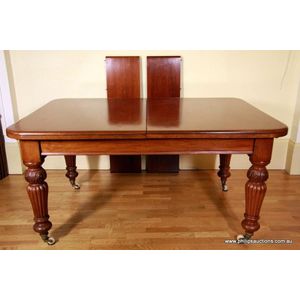William IV Mahogany Extension Table, 1830s
You must be a subscriber, and be logged in to view price and dealer details.
Subscribe Now to view actual auction price for this item
When you subscribe, you have the option of setting the currency in which to display prices to $Au, $US, $NZ or Stg.
- Turned Legs - are legs which have been turned on a lathe. In use from the 16th century, turned legs on tables, chairs and cabinets became more frequent until, by the 1830s, the Georgian square or tapered leg was rarely found except in country pieces.
- Turning - Any part of a piece of furniture that has been turned and shaped with chisels on a lathe. Turned sections include legs, columns, feet, finials, pedestals, stretchers, spindles etc. There have been many varieties and fashions over the centuries: baluster, melon, barley-sugar, bobbin, cotton-reel, rope-twist, and so on. Split turning implies a turned section that has been cut in half lengthwise and applied to a cabinet front as a false decorative support.
- Skirt - In furniture, the skirt is a strip of wood underneath the top or front of the item. On chairs, the skirt is the support under the seat joining the legs, while on tables, the skirt is the support under the top, that assists in supporting the top and also joins the legs. On carcase furniture such as chests and cabinets, the skirt is the timber strip immediately under the drawers or cupboard.
- William Iv - William IV was King of the United Kingdom and King of Hanover from 26 June 1830 until his death in 1837, and in English furniture design it represented the brief period between the end of the Regency period, and the beginning of the Victorian period.
- Mahogany - Mahogany is a dense, close grained red-coloured timber from the West Indies and Central America. It was first imported into Europe in the the early 18th century and its use continued through the 19th century. It was popular for furniture making because of its strength, the wide boards available, the distinctive grain on some boards, termed flame mahogany and the rich warm colour of the timber when it was polished.. The "flame" was produced where a limb grew out from the trunk of the tree, and this timber was usually sliced into veneers for feature panels on doors, backs and cornices.
Some terms used to describe mahogany relate to the country from which it originally came, such as "Cuban" mahogany, "Honduras" mahogany etc. However unless the wood has been tested the names assigned are more a selling feature, rather than a true indication of the timber's origin.
This item has been included into following indexes:
- tables, large dining
Visually similar items

A Victorian mahogany extending dining table, 1870s/'80s, the rectangular top (with two spare leaves) with a moulded edge above a plain frieze, raised on turned legs with brass caps and castors. Height 75 cm. Length 238 cm. (extended) width 125 cm

A Victorian cedar extension dining table. second half 19th century, with two extension leaves and winder, the square table with rounded ends above a deep skirt with a reeded trim and supported on four waisted baluster reeded legs with foliate carved caps,

A William IV cedar extension table, circa 1830s, with three leaves and winder, the table with rounded corners having a thick top above an extended bullnose edge, a deep skirt and raised on relief carved knopped and centurion skirt style baluster legs and t

A Victorian cedar extension dining table. 19th century, of solid and substantial form, the top with a thumb nail and bullnose edge, having a deep skirt and supported upon cup and tapering baluster legs terminating in brass casters; having three additional
